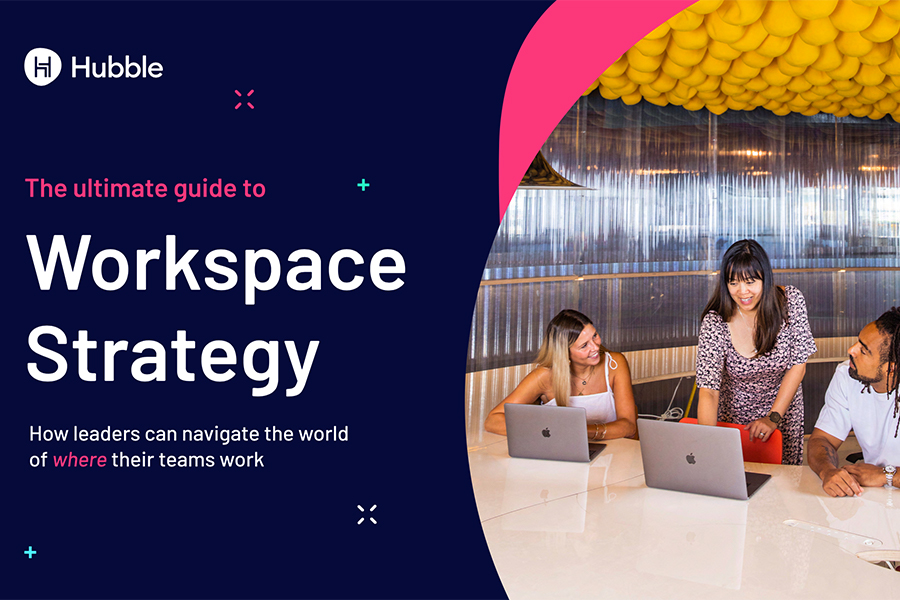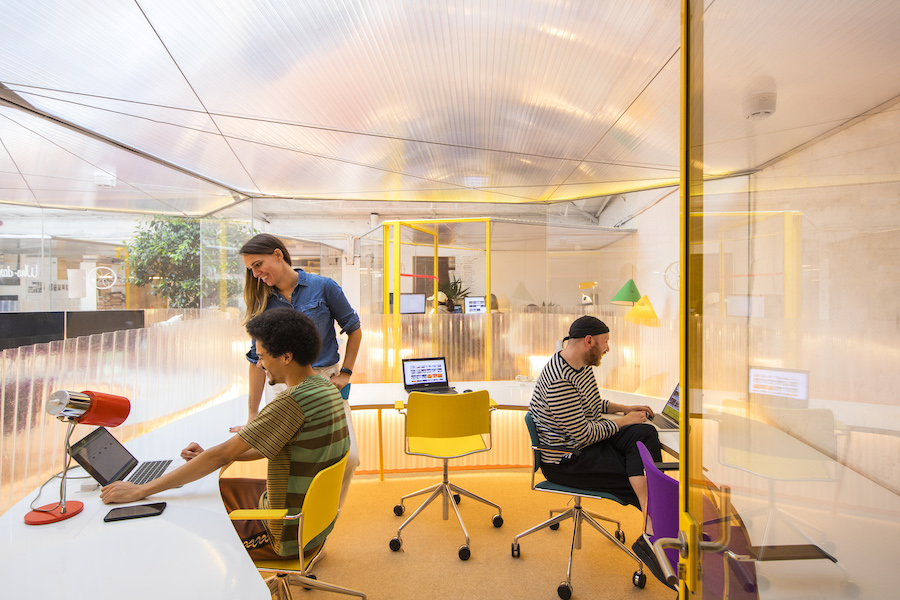- What is ‘workspace strategy’?
- Fully Remote Workspace Strategies
- Preference-Based Hybrid Strategies
- Time-Based Hybrid Strategies
- Set-Day Hybrid Strategies
- Fully Office-Based Strategies
- Download your FREE guide!
- FAQs
So, you’ve been tasked with reinventing your company’s workspace strategy, and you’ll know there’s plenty to consider. You need to survey your team, stick to the budget and ensure you land on a workspace solution that’ll truly serve the needs of your business.
But at Hubble, we believe every workspace strategy should be unique. In the hybrid working era, there is no one-size-fits-all definition. Whether you’re a budding startup or a flexible enterprise, our advice is to reshape and mould your workspace strategy however you see fit.

But as a decision-maker, you may feel overwhelmed with the possibilities on offer. But luckily, Hubble’s here to help guide you.
From Olio to Taskrabbit, our flexible workspace platform has helped thousands of businesses with their workspace strategies — from exploring the options to successfully implementing them.
In this article, we touch on five popular workspace strategies and their pros and cons, so you don’t have to. Let’s go!

What is ‘workspace strategy’?
The term ‘workspace strategy’ is commonly used, so let’s briefly explain what it actually means.
In short, a company’s ‘workspace strategy‘ refers to how decision-makers configure, manage and utilise the physical work environment.
This is not to be confused with workplace strategy, which goes beyond just the physical space and focuses on creating a productive and engaging workplace for employees.

Instead, workspace strategy focuses exclusively on the physical work environment. This may include decisions about:
- The location(s)
- The number of desks
- The specific amenities, such as gyms or on-site parking.
You may also consider additional ‘third spaces’, such as on-demand workspace to support flexible working, as well as equipment for employees’ home setups.
On-demand workspace refers to flexible workspaces teams can book by the day or hour, whenever and wherever needed.
Whether it’s a day office in London or a meeting room in Manchester, on-demand workspace is a low-cost and zero-commitment way to keep hybrid and remote employees productive and engaged.
1) Fully Remote Workspace Strategy

So, let’s dive into the various workspace strategies decision-makers can consider — the first being a remote work strategy.
It’s pretty common for people to think a “remote-first” strategy means only working from home. But that’s not always the case. Remote working enables employees to flexibly work from various locations rather than having to be physically present in a centralised office.
With a fully remote setup, employees can truly work from anywhere. This could include flexible workspaces that are bookable on-demand — such as coworking spaces and private day offices — or any other location that suits their specific needs.
What are the pros and cons?
| Pros | Cons |
| Cost-savings Office rent is the second-highest fixed cost for most businesses. This affordable workspace strategy eliminates the need to rent a full-time office, allowing you to cut back on utilities and maintenance expenses. | Poor cultural visibility Building a strong team culture is challenging when your team aren’t physically close or having regular face-to-face interactions. This can result in a lack of cultural visibility, leading to confusion and inconsistency in how people behave. |
| Diverse talent pool With remote working, you can hire top-quality talent from anywhere in the world, regardless of their location. This flexibility removes barriers imposed by proximity to the central office and attracts skilled individuals who may be unable to relocate. | Weaker collaboration Operating without a dedicated office space can pose challenges to effective collaboration — especially if you’re not utilising on-demand workspace. It can limit spontaneous interactions, impede in-person communication, and delay decision-making amongst teams. |
| Employee wellbeing By implementing a remote work strategy, you can ensure employee satisfaction by enabling them to tailor their work-life balance according to their personal preferences and requirements. | Employee isolation Not having a full-time office or access to on-demand workspace can create a sense of isolation among employees. The absence of face-to-face interactions can lead to feelings of disconnection and limited chances for informal networking and support. |
Taskrabbit: Boosting flexibility and saving money — all with Hubble On-Demand!
By not taking a full-time office for the whole team, and, instead, opting for an agile remote work strategy, Taskrabbit has saved an estimated 87% — all via Hubble On-Demand.
Hubble On-Demand is a flexible, workspace membership that gives teams access to a global network of thousands of amazing spaces to work, meet in person and collaborate.
With it, 400+ of Taskrabbit’s employees are exercising their freedom to take a break from WFH and collaborate with the team, whenever and wherever they want!
2) Preference-Based Hybrid Strategies

Next, we’ve got a ‘preference-based’ hybrid workspace strategy. This is where employees choose their preferred work location, which can either be in the company office or remotely — and their choice is entirely flexible and dependent on their individual needs and work preferences at any given time.
So, if you’re an employer who values instilling trust in your team, this flexible workspace strategy is ideal. These companies embrace hybrid working, recognising that different employees will have varying preferences, personalities, and circumstances that influence their work environment choices.
What are the pros and cons?
| Pros | Cons |
| Employee empowerment You’re able to maximise productivity, work-life balance, and job satisfaction. This also cultivates accountability and ownership by entrusting employees with the authority to make their own decisions. | Employee dissatisfaction The flexibility can sometimes contribute to “empty desk syndrome” — where businesses commit to office space with lower occupancy rates, and end up paying for desks that go unused, leaving businesses with poor ROI. |
| Office spend optimisation You can save costs by cutting down expenses associated with an office space with a large number of desks, allowing resources to be allocated more efficiently to support other business needs. | Decrease in office utilisation When employees have the choice to come into the office or not, it can lead to wasted trips. This is where individuals decide to come in only to find themselves sitting in an empty office, essentially forking out to replicate the WFH experience. |
| Boost in productivity When employees have the flexibility to work in environments that suit their productivity and comfort levels, it can lead to enhanced efficiency and increased output. | Lack of team cohesion Without regular in-person interaction, fostering a strong sense of camaraderie and team spirit may be tough. Not only can this impact collaboration, but it can also damage the team dynamic — so it’s important to strike a balance! |

3) Time-Based Hybrid Strategies

Then there’s a “time-based” hybrid workspace strategy. This hybrid working approach is where employees can split their time between working in an office and remotely, based on predetermined schedules or designated days.
In other words, employees must work a set number of office days per week but can choose specific days. This type of hybrid work ideal for companies that want to provide employees with a structured and predictable schedule while still promoting flexibility and autonomy around workspace.
What are the pros and cons?
| Pros | Cons |
| Employee empowerment By enabling your team to customise their workweek, you foster a culture that values employee autonomy and flexibility, while still prioritising regular opportunities for in-person collaboration. | Desk under-utilisation Since most employees choose to work in the office on Tuesdays to Thursdays, this strategy can result in the office being underutilised on Mondays and Fridays — leading to wasted resources and spending. |
| Decrease in wasted office trips This hybrid work strategy minimises the instances where individuals come to the office only to find it unnecessary or less productive, by ensuring employees schedule their visits to align with their designated workdays. | Employee dissatisfaction Employees who were initially hired as remote workers may end up facing longer commutes, especially if they reside far from the office. Not only can this lead to employee dissatisfaction, but it can also cause a dip in productivity. |
| Boost in productivity The presence of team members in the office on the same day works wonders for fostering spontaneous and fruitful interactions and collaboration, creating a conducive environment for productivity. | Overcrowded office days Opting for a time-based hybrid strategy can sometimes result in the office feeling overcrowded on certain days. This can potentially impact employee comfort, workspace availability, and overall productivity. |
4) Set-Day Hybrid Strategies

A “set-day” hybrid workspace strategy is where employees have designated set days for working in the office and working remotely. With this hybrid work strategy, employees are expected to follow a consistent and pre-determined schedule between office and remote work.
In other words, the specific weekdays (and how many) are typically ‘mandated’ — meaning it’s the employer who decides and not the employees.
What are the pros and cons?
| Pros | Cons |
| Predictable desk utilisation rates Setting up specific office days allows employees to make the most of their desks, resources, and facilities the workspace has to offer. This helps facilitate effective planning and collaboration within teams while ensuring you’re getting your money’s worth. | Fragmented team culture By having employees split their time between remote and in-office work, you could give rise to communication gaps or proximity bias — as teams will have to navigate hybrid meetings. |
| Improvement in company culture This hybrid work strategy can cultivate a sense of camaraderie and inclusiveness among employees, as they gather together on these scheduled days. This promotes in-person interactions, strengthens team cohesion, and nurtures a shared sense of purpose. | Greater sense of division among teams Employees with different office days may experience a sense of division within teams, as some teams may have more face-to-face interaction and collaboration opportunities than others. |
| Boost in productivity Allocating specific office days can boost productivity by establishing a structured routine that enables employees to concentrate on deep work when in the office. | Decrease in employee flexibility Set-day hybrid work strategies can run the risk of limiting employee flexibility. This is because they’re required to adhere to specific days set by the employer, potentially restricting their ability to adapt their work schedule to personal or unforeseen circumstances. |
5) Fully Office-Based Strategies

Finally, we’ve got companies who’ve identified that work will continue to occur in the HQ: a centralised office space where employees are expected to be physically present five days a week during regular business hours.
If you’re opting for a fully office-based workspace strategy, your office has got to be somewhere your team feels happy and productive. It’s where everyone is going to be spending most of their time, so it’s got to be worth the commute and the lunch out!
What are the pros and cons?
| Pros | Cons |
| Solid desk utilisation rates Since employees are expected to primarily work in the office, the likelihood of desks remaining unoccupied is significantly reduced. With this strategy, there’s no risk of experiencing “empty desk syndrome“. | Drop in employee flexibility Increased risk of being seen as inflexible and unsupportive of employees’ autonomy, freedom, and preferences. This can damage employee retention and the chances of attracting skilled individuals. |
| Stronger collaboration With this strategy, you’re giving employees access to a single physical environment where they can easily interact with colleagues. They can engage in “watercooler chats”, build organic connections and be better positioned to creatively problem-solve. | Employee expenses increase Having a fully office-based workspace requires employees to commute regularly, leading to increased travel time and expenses. This may harbour feelings of dissatisfaction among employees who need to cut back on expenses. |
| Company culture occurs more organically This strategy can contribute to a strong company culture by creating opportunities for shared experiences, building relationships, and fostering a sense of belonging and camaraderie among employees. | Operational costs increase Maintaining a physical office space involves significant expenses, which can increase operational costs for organisations — especially if you commit to a longer-term lease with hefty exit fees. |
The Ultimate Guide to Creating and Implementing a Successful Workspace Strategy

Interested in exploring a workspace strategy tailored to your business and finding the right solutions to support it? Download: The Ultimate Guide to Workspace Strategy!
This definitive resource is free and concise and will introduce you to numerous opportunities to implement a workspace strategy that genuinely benefits your team. Don’t miss the chance to grab your complimentary copy today!

FAQs
Why is workspace so critical to employee success?
By offering different workspace options, it is much easier for employees to focus and crack on with the task at hand. Whether it’s an hourly meeting room or a private, part-time office, an appropriate workspace can get employees into the right headspace and help them be more successful.
What are the components of workspace strategy?
The most successful workspace strategies will be unique to each company, taking into account your company values and business goals. Your workplace strategy is made up of tools (including virtual), physical office space, budgets, employee preferences/behaviour, and company culture.
What are the goals of workspace strategy?
The purpose of a workplace strategy is to ensure the range of physical spaces supports long-term business goals. Whether it’s fostering collaboration, saving money, or giving employees more flexibility, a good data-driven workspace strategy can help you achieve the goals of the business.
What is hybrid working?
Hybrid working refers to a blend of office and remote work, with the individual and organisation deciding how to split their time. Whether it’s a set-day or preference-based hybrid strategy, this flexible work solution works best when it’s aligned with a businesses work practices and employee preferences.
If you’d like to learn more about hybrid working, check out our ultimate guide!
What is flexible workspace?
Flexible office space (or ‘flex space’) is an umbrella term for many types of workspace, including including serviced offices, part-time offices and on-demand workspace, such as coworking spaces, hot desks and meeting rooms. What makes these types of workspaces ‘flexible’ is their low-commitment terms and increased levels of agility.
